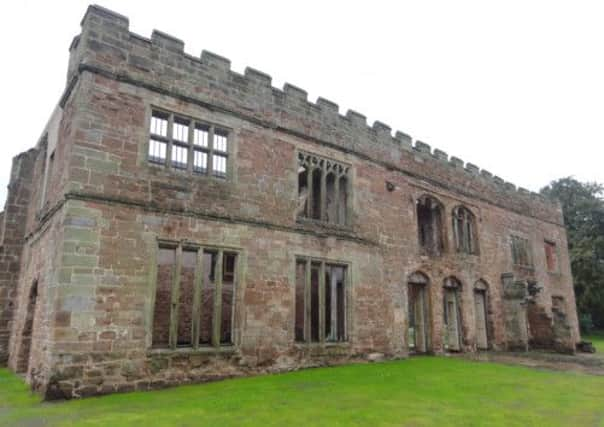Preserving old ways to create the new earns top award


Builders have suffered a dreadful recession but there are a few exceptions and Tony Townend is one of them.
“There isn’t a day when I don’t bounce out of bed and look forward to going to work,” says Tony, managing director of York-based conservation specialists William Anelay Ltd.
Advertisement
Hide AdAdvertisement
Hide AdHe jumped for joy recently when the company’s latest project, Astley Castle, won the prestigious RIBA Stirling Prize for Architecture.
Deemed one of the most complex restorations ever undertaken in the UK, the 800-year-old Warwickshire castle has been transformed from a derelict shell into a stunning holiday home for the Landmark Trust.
The £1.3m build, which took 20 months, saw William Anelay working with architects Witherford Watson Mann, to create a new property within the ruins.
The moated castle’s remains date back to the 12th Century and have links to three Queens of England. In the mid 15th Century, it was home to Elizabeth Woodville, who went on to marry Edward IV and bore him the ill-fated Princes in the Tower.
Advertisement
Hide AdAdvertisement
Hide AdHer daughter, Elizabeth of York, went on to become wife of Henry VII and mother of Henry VIII. Astley was also home to Lady Jane Grey, the nine-day queen.
From the 1930s until the late seventies the castle served as a hotel but a fire in 1978 gutted the building.
“The structure was in serious risk of collapse and one of the main problems was making it a safe place to work. Then there was the challenge of creating a modern building in an historic structure,” says Tony.
Over 270 Cintec anchors were inserted to stabilise the existing remains. Plans for the new build were so detailed that every single brick was shown on the drawings. The brickwork pattern, designed specifically for the project, had never been used before so around 50,000 bricks had to be made and imported from Denmark.
Advertisement
Hide AdAdvertisement
Hide Ad“Everything was so exact with this job and being just a millimetre out could have affected everything. We spent six weeks doing them sample panels so they could choose the right brick,” says Tony.
“But it was well worth the effort. It is a fantastic, ground-breaking project.”
Stirling prize judges thought so too and the accolade is the 13th this year for Anelay’s, which was launched in 1747 and still has a member of the family at the helm.
Company chairman is Charles Anelay, who staged a management buy-out with three colleagues in 2006, just before a credit crunch that devastated the construction sector.
Advertisement
Hide AdAdvertisement
Hide Ad“It’s been a tough time but we have been lucky compared to some of our competitors and things are getting better,” say Tony.
Most of their work is restoration and conservation of old, often listed, properties, and ecclesiastical buildings, including York Minster, though one of their latest projects is a prestigious new-build for a wealthy client in West Yorkshire. They are also working on Castle Drogo in Devon for the National Trust.
They specialise in traditional techniques and have their own team of over 100 craftsmen masons, joiners, lead workers, roofers and bricklayers along with apprentices, so that age old skills can be passed on to a new generation.
Many of the historic buildings they work on have suffered from unsympathetic extensions and the use of modern materials, like gypsum plaster. Anelay’s use lime and horse hair plaster which allows a building to breathe.
Advertisement
Hide AdAdvertisement
Hide AdAnother issue is cement strap pointing that stands proud of the stone face and doesn’t breathe, expand and contract. When water gets into the stone and freezes, it blows the face off and causes erosion. That kind of pointing needs to be replaced with lime mortar.
The company is also expert at introducing insulation and more efficient heating in draughty, fuel guzzling cathedrals. This involves taking up the floor and putting in underfloor heating.
Anelay’s sensitivity and knowledge of historic building techniques and materials is impressive but if they need help, they can consult their 266-year- old library.
“We’re never left scratching our heads. We just go and look at one of the books. We have an amazing archive detailing everything from jointing to masonry techniques,” says Tony, who also works closely with archaeologists.
Advertisement
Hide AdAdvertisement
Hide AdAt every point where new ground was broken at Astley Castle they had to call in a “time team” to check for buried treasures.
Pottery, Roman coins and bones are regularly unearthed on many of their sites. Their most striking find was a Roman road and a burial site containing 138 skeletons at 12th century Syningthwaite Priory, near Wetherby, where they were renovating old farm buildings.
“That was the most memorable days by far,” says Tony. “But in one way or another every day is different for us and that’s why I love the job so much.”
www.williamanelay.co.uk; www.Landmarktrust.org.uk
Twitter: @PropertyWords